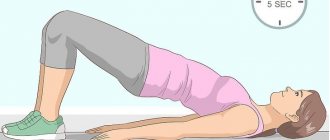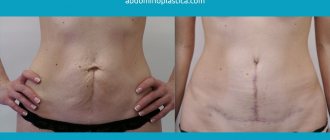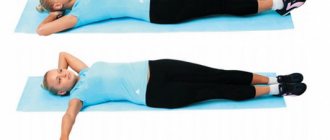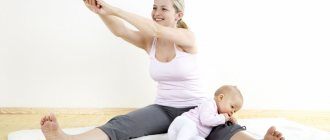How long does the recovery period after childbirth last?
The body's return to its natural state begins during childbirth. The apex of the sacrum deviates, pronounced vertebral curves are smoothed out. Over the next 6-8 weeks, this process is completed: intense contractions of the uterus help normalize its size, the pelvis closes, and menstruation resumes.
To stay in shape, many young mothers tend to go to the gym as soon as possible. But intense training in the postpartum period can be harmful to health; preference should be given to exercise therapy and visiting an osteopath.
When can you start exercising after giving birth?
The ideal option would be to resume classes 3-4 months after giving birth. But this does not mean that a woman can return to full-fledged training in her favorite fitness center.
First, she will need to visit a physical therapy doctor. Physical therapy is indicated not only during pregnancy, but also during the rehabilitation period after childbirth. Unlike a gym trainer, a physical therapy doctor understands the anatomy of the female body and knows its capabilities and limits after childbirth.
Therapeutic physical culture allows you to start the processes of restoring the biomechanics of the body. The return to usual training should be gradual, always under the supervision of a specialist. During the postpartum period, group training is not suitable, since recovery occurs very individually. During this period, it is advisable to regularly visit an osteopath for preventive purposes. This specialist will check the condition of the muscles, bones, ligaments, give direction for further training, and relieve pain.
Kinds of sports
Regular sets of exercises can be performed at home within 1-1.5 months (approximately) after cesarean section. As for serious sports, here you will need to focus on the problem they solve and the doctor’s permission.
- Swimming (water aerobics)
After cesarean section, this sport is allowed to be practiced 2 months later. This is exactly the period required for the complete restoration of the mucous membrane inside the uterus. Swimming relieves tension, strengthens different muscle groups throughout the body, tones, and prevents obesity.
- Yoga
Many yoga centers offer sets of exercises for women who have recently given birth. This sport perfectly tightens muscles, teaches you to control emotions and relax.
- Pilates
One of the areas of fitness, Pilates allows you to return to active sports 4-5 months after cesarean section, provided that the young mother feels well. It solves most postpartum problems: it tightens the stomach, strengthens the chest and back muscles, and helps the body recover faster.
- Run
Despite the fact that running is an effective way to get your figure back in order, it has too powerful an effect on the body and the organism as a whole. Experts will allow you to use this sport after a caesarean section in 8-9 months at best. But the most optimal period recommended by doctors is no earlier than a year.
- Gym
No less effective technique than running, but just as aggressive. Although a lot here will depend on the coach. If he selects an individual training program for you, designed for the postoperative period, you will be able to start your first light classes after six months.
Since you can return to serious sports after a cesarean section only after a long period of time, many women are content with light physical exercises that can be performed at home to restore their figure. If there are special complexes that are developed for young mothers who have undergone this operation.
What is the importance of postpartum recovery?
The pelvis is the support for the spine. The pelvic region contains muscles, bones and ligaments that protect the reproductive system, bladder and intestines. And, of course, all these organs require a complete blood supply. Pregnancy dictates its own rules, and a restructuring of the woman’s entire body, including the pelvis, occurs. Certain muscle groups are forced to be in constant tension, which entails rigidity in other groups. Possible compression of the nerves and the occurrence of pain. An osteopathic doctor can help you get rid of unpleasant sensations.
Scar after cesarean section
To extract a baby during a cesarean section, it is necessary to make an incision through all layers of the anterior abdominal wall and the lower third of the uterus. Like any surgical intervention, this does not go away without leaving a trace. Therefore, it is important to recover properly, visit exercise therapy and an osteopath.
Caesarean section is one of the main causes of scarring on the uterus. Scar tissue is connective tissue that forms at the site of injury during the regeneration process. In itself, it does not pose a danger to a woman: the scar does not have a significant impact on a woman’s life. But this happens only until the woman thinks about giving birth again. A uterine scar is a complication associated with a cesarean procedure for a subsequent pregnancy. Connective tissue does not have one of the important properties of muscle - extensibility. Therefore, during pregnancy and labor, the uterus can be severely injured and ruptured along the scar line.
Effect of scar on body biomechanics
The body of each person is a single mechanism, where damage to one organ or tissue will entail consequences for others. This also applies to the scars that remain in a woman after a cesarean section. People who have large scars often turn to specialists with the following complaints: back and joint pain; · headache; · a feeling of discomfort of unclear localization. Scar tissue is a dense framework. It is capable of replacing other lost tissues, but is not able to replace their functions. The scar forms tension, which “pulls” other tissues onto itself, changing the vector of tension in the body. In turn, stress vectors affect not only muscles and organs, but can also adversely affect bone structures. A transverse scar can cause impaired mobility of the pelvic bones. Because of it, the lower extremities do not receive sufficient blood supply and constantly suffer from hypoxia. Another unpleasant consequence of a scar is the weakening of the pelvic floor muscles.
Osteopathy cannot heal a scar, but it can make it softer and more pliable. Due to this, tension will decrease and discomfort will subside. Thus, the osteopathic doctor does not muffle the symptoms, but purposefully acts on the causes of pain and discomfort. The sooner a woman begins to recover after a cesarean section, the fewer unpleasant consequences she will expect in the future.
The first two months after surgery: I want it, but it hurts
When can you exercise after a caesarean section? This question worries all pregnant young mothers, because without fitness and aerobics it is simply impossible to achieve the desired shape! Many people make a fatal mistake and begin to torture their body with exercises only a month or two after the operation. This is very dangerous - the tissue at the incision site is still poorly fused, and the slightest load can lead to the seam coming apart. And if this happens, then the impatient mother will have to forget about playing sports for a long time.
If you really can’t sit still, then you can slowly start doing the following exercises (at the slightest pain or discomfort, you should immediately stop any physical activity):
- Light squats . This is a great exercise that uses virtually no abdominal muscles. But it will help tone your hips and buttocks. At this stage, you should not use any weights - forget about dumbbells and barbells for now! If it’s still difficult for you to squat deeply, let it be light squats, a light warm-up.
- Arm swings - “mill” and “swimmer”. Very simple, almost warm-up exercises. You need to swing your arms, reminiscent of a spinning mill. This will tone the joints of the arms, neck and muscles that support the thoracic spine.
- Leg lunges forward and backward. Don’t force yourself - don’t let the attacks be particularly deep. Remember safety precautions: the knee should not extend further than the toe. Improper execution can lead to knee injury. Remember: at this stage we are warming up rather than giving the body a real load. Abdominal surgery is a serious stress even for the healthiest person, let alone a pregnant woman!
- Stretching . Don’t be overzealous: slowly do exercises to stretch the muscles of your legs and arms. Do not touch the abdominal muscles, this may cause the seam to come apart.
Features of children born by caesarean section
Children born naturally and by caesarean section are practically no different. There are many myths about “Caesareans”: · hyperactivity; · retardation in physical development; · mental retardation, etc. They do not have a scientific evidence base and should not cause concern to the mother. Complications with cesarean sections do occur, but are quite rare. These include: · disturbances in the functioning of the respiratory system; · dislocation of the cervical vertebrae; · increased nervous excitability; · change in muscle tone (can either increase or decrease). To correct these conditions, it is not necessary to resort to drug therapy. Most of them can be corrected with the help of exercises; in rare cases, it is permissible to use dietary supplements approved by a doctor.
Osteopathic work with the “child-mother” pair
Childbirth is a process where both mother and baby are exposed to heavy stress. Therefore, it is important to competently create an exercise program for both participants in this difficult process.
A child undergoes a serious test during labor, not only in the case of a cesarean section. Often, to stimulate labor naturally, forceps, vacuum technologies, and “squeezing” techniques are used. In such circumstances, the baby's skull is subjected to heavy stress, and there is a risk of damage to the cranial nerves. In addition to the skull, the spine and pelvic bones can be traumatized. Without appropriate exercises, these conditions will lead to impaired growth and development, and curvature of the spine. In the future, such a child will suffer from joint problems and constant back pain.
Children who were born by cesarean section especially need the supervision of an osteopathic doctor. They did not receive natural stress and natural modeling, like children during natural childbirth. In this situation, the formation of the most important ossification points of the cranium becomes difficult.
The body of a new mother is also under stress. During pregnancy, a significant expansion of the pelvic bones occurs, and the elasticity of the ligaments increases. All this is necessary for childbirth to proceed easily. But, as practice shows, it is difficult for a woman’s body to return to the state it had before pregnancy on its own. The woman’s pelvic bones should narrow and the ligaments should stabilize. But if this process is not controlled, the bones can deviate from their natural axis by several millimeters. At first glance it may seem that this is quite insignificant. But meanwhile, women who have had a shift in the pelvic bones suffer from chronic pain in the lower abdomen, and over time, deformation of the organs is discovered.
Childbirth is only part of the stress a woman experiences when a baby is born. Caring for a child also puts additional stress on the female body: a forced position while bathing the child, putting him in a crib, constant stress on the spine and pelvis when rocking him to sleep.
Many women suffer from depression during the postpartum period. Changes in hormonal levels, lack of sleep, constant muscle tension - all this negatively affects the mother’s condition. Regular exercises with an osteopath after childbirth will help you avoid even such consequences.
That is why it is important to understand: visiting an osteopathic doctor will help mother and child lead a healthy and fulfilling life. Both organisms go through great stress, so rehabilitation is given special importance. At an early age, there is an inextricable connection between a mother and her baby; they very sensitively feel each other’s moods and pains. It is recommended to visit an osteopath immediately after discharge from the maternity ward, especially after a caesarean section. He will examine the mother and child and prescribe the necessary exercises for both of them.
Recommended Exercises
For women who were actively involved in sports or fitness before pregnancy and during pregnancy, rehabilitation exercises after cesarean section can be accelerated after the stitches are removed and discharged from the hospital. However, there are pitfalls here too. Exercising with excessive physical stress after a caesarean section is not yet available to you. Rush things gradually, giving your body time to fully recover.
Exercise allowed after a cesarean section consists of two stages: restorative and traditional. The recovery period begins 6 hours after surgery. It includes breathing training and delicate movements performed without tension, with voluntary breathing, and at a slow pace. Classes are held under the supervision of a doctor. Traditional therapeutic exercises are started 6 weeks after birth. It includes exercises that do not require special tension on the abdomen and perineum. 1.5 months after the caesarean section, the intensity of exercise increases, but without undue stress.
Gymnastics for the respiratory system
Breathing training tones muscles and helps a woman achieve peace of mind after a complex surgical procedure. The first week after giving birth is great for breathing exercises. They are performed in the following order:
- Alternating shallow and deep breathing.
- Take a long breath, then exhale at the same pace.
- Inhale short and exhale long.
- Breathe a little with your chest, then with your stomach.
Repeat all exercises 8-10 times.
During breathing exercises, you need to inhale through your nose and exhale through your mouth. To control the breathing movements of the stomach, the hands should be placed on the suture to monitor its tension and reduce the breathing amplitude in time. Such exercises in the first days after surgery help normalize blood flow, saturate the blood with oxygen, and have a calming effect.
For the press
Caesarean section negatively affects the abdominal muscles, which are already greatly stretched and weakened after pregnancy and childbirth. Having lost muscle tone, the stomach sags, and the woman wants to get rid of it as soon as possible. The task is extremely difficult, because if you immediately start pumping up your abs, there is a high risk of the seams coming apart. Here it is important to be patient and wait until the doctor gives the go-ahead for the necessary physical activity allowed after a cesarean section. Rushing can result in serious complications that will delay recovery for a long time.
When can you get serious about your abs? For patients who were not lazy to train their body even before pregnancy, abdominal exercises can be started after 4-5 months, but for those who are not familiar with physical education and sports, they should start exercising only after 6-7 months. Some, even the simplest exercises, should be done under the supervision of a specialist:
- Lying on your back, inhale, bend your knees without tension, pull them to your chest, exhale.
- Roll over onto your stomach. Inhaling, inflate it, exhaling, draw it into yourself.
- Lie down on your back again. Raise your legs slightly so that they are parallel to the floor. If possible, move them apart and bring them back. Repeat several times, but so that you do not feel tension or fatigue.
- Sit on the edge of a chair. Lift your legs off the floor and stretch them forward. Now spread it out a little. In the future, the amplitude of movement can be increased.
Do everything 5-10 times.
Lightweight and easy-to-perform movements properly target the abdominal muscles and help a woman breastfeeding after a cesarean section prevent stagnation of milk.
For the belly
The skin on the abdomen, stretched during pregnancy, forms unsightly folds after childbirth. A set of exercises aimed at working out the entire muscular corset of the entire abdominal and thigh area will help to remove them after surgery. If you want to quickly get a thin waist and a toned stomach, do the following exercises:
- Lie on one side, lift your straight leg up. We change position, work with the other leg.
- Standing on all fours, we work with our stomachs. Inhaling, we draw it in, exhaling, we relax it.
- We stand straight, our hands are on our belts, we lean either to the left side or to the right side.
- Lie on your back, arms lie along your body, legs bent at the knees, begin to raise them to the height that is comfortable for you.
- “Scissors” In this exercise you need to be careful not to spread your legs too far and not to make sudden movements.
Repeat 6-10 times.
If you feel pain during abdominal exercises after childbirth, stop exercising until you have fully recovered. When starting again, control your condition, do not overload, and be sure to tell your doctor about your discomfort.
Osteopath after childbirth: in what cases is it necessary to contact?
A visit to an osteopath after childbirth is not a mandatory procedure, but rather a recommendation. However, it is worth knowing about the symptoms when seeing a doctor is necessary: · Pain in the tailbone or sacroiliac joint. Their appearance provokes sprains during the passage of the child through the birth canal. The large weight of the fetus can aggravate the situation. · Pain in the pubic symphysis. Another consequence of sprained ligaments during childbirth. The pain is acute, entails a change in the biomechanics of the whole body, a constant forced position leads to weakening of the abdominal muscles. · Back pain. If a child is a frequent guest in the mother’s arms, then the spine and pelvis will painfully respond to the heaviness. · Headaches, pain in the cervical spine. They arise as a result of incorrect posture when breastfeeding the baby, as well as incorrect posture during sleep. · Change in the position of the sacrum. Organs receiving innervation from the sacral plexus suffer from discomfort. And due to disturbances in muscle function, pinching of the sciatic nerve is possible.
The baby should definitely be shown to an osteopathic doctor if there was a difficult birth. Also reasons to come for a consultation are the presence of any asymmetry, frequent colic and regurgitation, hip dysplasia.
Caesarean section or natural childbirth: which is more traumatic for a woman’s figure?
As a result of natural childbirth, the abdominal muscles are not cut with a scalpel; the uterus quickly returns to its previous size, which means that the abdomen quickly returns to its prenatal shape. In the case of a caesarean section, things are more complicated. This is a full-fledged abdominal operation, which is performed under anesthesia. The muscles of the lower peritoneum are cut with a scalpel, and the child is taken out through the resulting hole. The incision is then closed with a special surgical suture. It is very important what kind of seam took place:
- horizontal or cosmetic (usually performed during a planned operation; in some maternity hospitals, the surgeon performs such a suture only by prior arrangement and for a fee);
- vertical - usually performed during an emergency operation when the life of the child or mother is in danger (there is no time to make a cosmetic suture, and the surgeon does not stand on ceremony when making the incision).
The exact answer to the question “when can you play sports after a caesarean section” will be different for each woman: it all depends on how she feels and the speed of healing of the suture.
is much easier to restore your figure and return a flat tummy if a cosmetic stitch has been made . In this case, after three to four months you can return to your pre-pregnancy clothing size. But if a rough, vertical seam , the situation is worse . The abdominal muscles are seriously damaged and serious efforts will have to be made to achieve a flat stomach. Most likely, you will first need to polish the scar with a laser (after the tissue has set and infection has been ruled out - that is, about a year after the operation), and only after that will you seriously engage in fitness to hone the desired shape.
Summing up
Pregnancy and childbirth are a serious test for the female body. Nowadays it is rare to meet a person who does not have any chronic diseases. And during this stressful period for a woman, all of them can become aggravated, cause additional discomfort, and bring anxiety.
To be sure of a favorable course of pregnancy and rehabilitation after childbirth, it is important to visit an osteopath for prevention.
In cases where the pregnancy was difficult, there was a caesarean section - a visit to an osteopath should be a mandatory procedure after discharge from the maternity hospital. This will help mother and baby recover faster and begin to live in harmony with their body.
A visit to an osteopathic doctor for a woman is the key to her reproductive health. After all, scars can become a serious complication during the next pregnancy.
An osteopath will help a woman return her organs to the desired position. The exercises performed restore muscle tone, and proper distribution of tension in the body occurs. Scars and scars become more pliable and elastic. There is relief from pain and discomfort. A woman’s life returns to normal faster, and her health improves.
Similar articles:
- Directions
- Specialists
- For visitors
- Articles and videos
“Healthy Summer” 1000 rubles discount on an appointment with osteopathic doctor E.A. Ukhmylin.
Adult admission 6 thousand, children admission 5 thousand.
What's prohibited
Whatever sport a woman chooses, for six months after surgery she should avoid:
- abdominal muscle training, abdominal pumping;
- sharp twisting, bending;
- squats;
- loads on the lower back;
- use of weights;
- jumping rope.
Any intense physical activity, and especially extreme sports (parachute jumping), professional training is strictly prohibited! It takes about a year for the body to fully recover from pregnancy and surgery. In addition, excessive physical activity can negatively affect lactation, which should be taken into account by women who are breastfeeding.
Sometimes complications arise after surgery that serve as an absolute contraindication to any sports:
- endometritis and uterine bleeding;
- poor fusion and suture divergence;
- elevated body temperature for a long time in the range of 37.1-38.0 ° C, which may indicate a low-grade inflammatory process;
- pathologies of the uterus after childbirth.
For at least 8–12 months after surgical birth, doctors do not recommend engaging in sports that seriously strain the heart and muscles:
- light and weightlifting;
- volleyball, basketball, football and similar sports;
- cycling;
- tennis;
- run.










